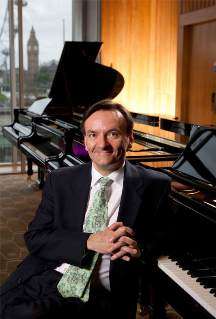|
Back
Perfect Pictures, Picture Perfect New York
Isaac Stern Auditorium, Carnegie Hall
05/09/2015 -
Claude-Achille Debussy: La plus que lente – Estampes – Children’s Corner – L’Isle joyeuse
Frédéric Chopin: Ballades No. 2 in F, Op. 38, No. 1 in G minor, Op. 23, No. 3 in A flat, Op. 47 & No. 4 in F minor, Op. 52
Stephen Hough (Pianist) 
S. Hough (© Andrew Crowley)
The minutes, even the seconds before the cool, elegant Stephen Hough walks on stage, our thoughts of music are secondary. Mr. Hough is more than an artist. He is the ultimate British polymath: political advocate, columnist, composer, arranger, expert on ballet and museums and everything in between.
Precisely at 8 p.m. he saunters on stage, put his fingers on the Steinway, and other thoughts...well, evaporate, giving way to the music itself.
Amongst other things, Mr. Hough is the ultimate programmer. For the concert last night, his alpha and omega were two short works by Debussy. In between were longer pieces by Debussy and, divided by the intermission, Chopin’s Four Ballades. And for one of the encores, a work by a composer who Debussy idolized, Edvard Grieg.
In other words, Stephen Hough has a mind (and of course fingers) which seems unruffled.
But like his American equivalent, Jeremy Denk, another pianist whose words are as elicatory as his fingers, Mr. Hough never makes his music anything but exhilarating, and at times last night, transporting us into another age.
This was especially true in La plus que lente, that most deceiving short work by Debussy. While it could be played like a takeaway, a soupçon of a popular tune, a Satie fragment, Mr. Hough turned the work, with its retardations, its subtle dynamics, into a an etching of another era. Just as one hears Offenbach when looking at a Toulouse-Lautrec poster of dancing girls, one sees a dark cabaret with La plus que lente played by Mr. Hough.
For the following Estampes, nothing was insignificant. Mr. Hough doesn’t offer the precise jewels of a Gieseking, not even an Impressionistic vision. His Balinese gamelan sounds were literal in Pagodes (like Ravel, his introduction to “Oriental” music was at a Paris world fair some years before), his Grenada Gardens were blatantly Spanish and he offered Gardens in the Rain so explicitly that one almost felt, afterwards, like taking off some soggy shoes.
But after all, Debussy rarely offered words like “sonata” or “symphony” to his music. In Stephen Hough’s words, these works were , “poems, vastly suggestive beyond their duration” (my italics).
The evening ended with more Debussy: Children’s Corner was not for children, for he essayed Doctor Gradus ad Parnassum with electric scales–as well as the aural banging of the piano at the end. The Snow is Dancing had the same unashamed meteorological picture as his earlier Gardens in the Rain, and, while politically incorrect, Golliwogg’s Cake-Walk was bumptious and even tender. The Wagner Tristan quote was as natural here, as Bach in Alban Berg’s Violin Concerto. It seemed appropriate rather than un canard.
Mr. Hough’s Chopin Ballades weren’t played consecutively. Maybe he wanted to get the explosive Second Ballade over with, because it did burst, perhaps more explosively than musically, though it gave vent to Mr. Hough’s wondrous technique. The First Ballade was more meticulous than frenetic, and he produced some opening faraway bell sounds that were most effective.
The last two Ballades were played with delicacy when necessary, explosions when Chopin called for them. But while Mr. Hough seems the most fastidious person on stage, one would never give that left-handed compliment of being actually fastidiously played.
The last work was L’Isle joyeuse, not to be compared to Lorenz Hart’s “We’ll turn Manhattan into an isle of joy.” Debussy died a few years before he could hear American pop music, though he doubtless would have approved.
Mr. Hough played the piece with spark and joy, he was never afraid to linger over the phrases, and even had a surprise. When the main theme was announced, he introduced it softly, deftly, as if reaching for the same mystical picture as La plus que lente.
That, with four encores (including the Grieg) was a kind a picture-perfect ending. Perfection itself is apt to be boring, but Stephen Hough’s perfection is a tool for creating the most evocative polychromatic pictures.
Harry Rolnick
|